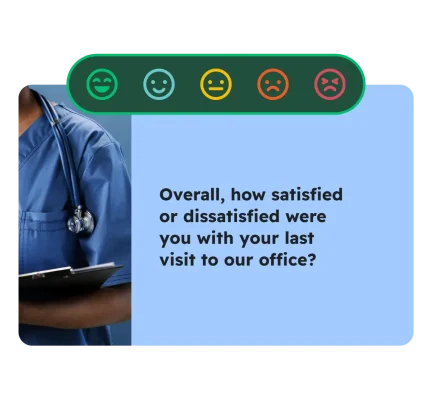40+ patient satisfaction survey questions
Improve patient experiences in your healthcare organization with patient satisfaction surveys.

Imagine attending an appointment to discuss treatment options for a serious illness. You voice your concerns and share your preferences, but your doctor doesn’t seem to listen. Wouldn’t you want the healthcare organization to know you felt unheard and dissatisfied with your care?
Patient satisfaction surveys bridge care gaps, build trust, and enhance health outcomes. They can uncover hidden frustrations that even the best clinicians might miss.
In this article, we share sample patient satisfaction survey questions, provide guidance on creating your own survey, outline the benefits, and offer additional information. Continue reading for detailed instructions on conducting healthcare surveys.
What is a patient satisfaction survey?
A patient satisfaction survey is a tool used by healthcare professionals to gather patient feedback and measure patient satisfaction, ultimately improving healthcare services.
Patient satisfaction surveys include questions about communication with doctors, wait times, staff behavior, care quality, facility cleanliness, and overall patient satisfaction. The goal is to understand what’s working well and identify areas for improvement to enhance patient care and service quality.
Patient satisfaction is crucial in healthcare settings because it contributes to improved health outcomes and overall wellbeing.
Improve your patient’s healthcare experience
Gather actionable insights with our expert-written healthcare survey templates.
Example questions in a patient satisfaction survey
When designing a patient satisfaction survey, it's helpful to focus on a specific part of the patient experience to gather more targeted insights. These sample questions can help guide the development of your customized survey.
Questions related to communication with healthcare providers
Effective communication with healthcare providers is a key factor in a patient’s overall experience. Use the sample questions below to help assess and improve patient satisfaction.
- On a scale of 1 to 10, how easy is it to communicate with your healthcare provider using the app?
- How responsive is your healthcare provider to your messages or concerns?
- Do you feel comfortable asking your provider questions during appointments or through the app?
- How satisfied are you with the amount of time your provider spends listening to you?
Questions related to wait times and scheduling
Long wait times can negatively impact the patient experience. It's important to evaluate how patients perceive appointment scheduling and the timeliness of their visits. Use the following questions to evaluate the timeliness of your administrative team.
- How satisfied are you with the amount of time you waited before being seen for your appointment?
- Was it easy to schedule an appointment at a convenient time for you?
- On a scale of 1 to 10, how reasonable was the wait time between booking your appointment and the actual visit?
- How well does the office communicate about delays, cancellations, or rescheduling?
Questions related to staff professionalism and courtesy
Staff behavior has a significant impact on patient satisfaction. Use these sample survey questions to gauge how patients rate the professionalism of your staff. The information gleaned from these questions can be used in future staff training sessions.
- How would you rate the professionalism of the front desk and support staff during your visit?
- Were you treated with respect and courtesy by all staff members?
- On a scale of 1 to 10, how comfortable did the staff make you feel during your visit?
- Did staff members clearly explain procedures, instructions, or next steps in a respectful manner?
Questions related to cleanliness and safety of the facility
Monitor your facility’s cleanliness and safety by regularly sending out patient surveys. Patients will indicate whether your facility is spotless or requires more constant cleaning. Use these sample questions to inquire about cleanliness.
- How would you rate the overall cleanliness of the facility during your visit?
- Did the facility appear to follow proper safety and sanitation protocols (e.g., hand sanitizers, mask use, equipment cleanliness)?
- On a scale of 1 to 10, how safe did you feel while inside the facility?
- Were restrooms, waiting areas, and exam rooms clean and well-maintained?
Questions related to quality of care received
Patient care is the foundation of every healthcare organization. To ensure you're delivering the highest quality care, it's essential to gather honest feedback from patients about their experiences. The sample survey questions below focus on how patients perceive the care they receive.
- How satisfied are you with the overall quality of care you received during your visit?
- Did you feel that your healthcare provider was thorough and attentive to your needs?
- On a scale of 1 to 10, how confident are you in the medical advice or treatment you received?
- Do you feel your concerns were taken seriously and addressed appropriately?
Questions related to mental and emotional well-being
Mental health visits are crucial to ensuring patient satisfaction. Do patients feel understood by their provider? Measure patient opinions on their mental health appointments.
- Did you feel emotionally supported and understood during your session?
- On a scale of 1 to 10, how comfortable did you feel discussing personal or sensitive topics with your provider?
- Do you feel your provider is helping you make progress toward your mental health goals?
- How well does your provider create a safe, nonjudgmental environment during visits?
Related: How to create a wellbeing survey
Questions related to virtual care or telehealth experience
If your healthcare facility provides virtual care or telehealth services, it's important to measure the patient experience. The following questions can help you evaluate and improve the quality and effectiveness of your virtual care offerings.
- How easy was it to access and use the telehealth platform for your appointment?
- On a scale of 1 to 10, how would you rate the audio and video quality during your virtual visit?
- Did you feel your concerns were addressed as thoroughly as they would be in an in-person visit?
- How satisfied are you with the convenience and overall experience of receiving care through telehealth?
Questions related to overall satisfaction and likelihood to recommend
Overall patient satisfaction matters. It supports a healthcare organization’s reputation and improves the likelihood of patients recommending your services. Use these example questions to measure patients’ overall satisfaction with your healthcare services.
- Overall, how satisfied are you with the care and services you received?
- On a scale of 1 to 10, how likely are you to recommend our practice to a friend or family member?
- Did your experience meet, exceed, or fall short of your expectations?
- Would you choose to return to this provider or facility for future healthcare needs?
Questions related to administrative and billing experience
Patients often have strong opinions about their billing experience, and it's important to understand their concerns. These sample survey questions are designed to gather feedback on the administrative and billing process.
- How easy was it to understand your bill and the charges listed?
- Were your insurance and payment options clearly explained to you?
- On a scale of 1 to 10, how satisfied are you with the billing and administrative support you received?
- How quickly and effectively were any billing issues or questions resolved?
Questions related to open-ended feedback
Give patients the chance to openly express their opinions about your healthcare facility by asking open-ended survey questions. Use these example questions to gather qualitative data from patients.
- Please share any additional comments about your overall experience with our team.
- What did you appreciate most about your visit or experience with our facility?
- Is there anything you feel could have been improved during your appointment?
- Do you have any suggestions for how we can enhance our patient care or services?
How to create a patient satisfaction survey
Interested in creating your own patient satisfaction survey? Reap the benefits of collecting feedback from patients by giving it a try. Follow this step-by-step guide to crafting effective patient satisfaction surveys to get started.
Step 1: Define your survey goals
Start by identifying the specific aspect of the patient experience you want to assess, such as communication, wait times, telehealth, or staff interactions. Focusing on a clear area helps you select relevant survey questions and achieve your survey’s goals.
Consider which areas matter most to your facility, and don’t hesitate to send multiple surveys at different stages of the patient journey to gather well-rounded feedback.
Step 2: Choose a trusted survey template
Easily create and distribute patient surveys with SurveyMonkey for Healthcare, designed for healthcare providers. Healthcare surveys can be some of your most effective tools in the healthcare accreditation process.
Get started with expert-built templates from CAHPS® and AHRQ®. Or use the Healthcare NPS Survey and the Health Insurance Evaluation Survey Template to improve care quality and enhance patient experiences throughout the healthcare system.
Alternatively, you can design custom surveys tailored to your organization’s needs.
Step 3: Customize your survey
After selecting a survey template, customize it to fit your healthcare organization’s specific needs. With SurveyMonkey, you can easily add, remove, or modify questions to align with your goals.
For more well-rounded insights, include a mix of multiple-choice and open-ended questions. You can also personalize the template with your organization’s branding to create a seamless, professional experience.
Step 4: Ensure compliance and privacy
You can’t forget about HIPAA compliance. Ensuring compliance not only safeguards patient privacy but also protects your healthcare organization from potential legal and financial penalties.
SurveyMonkey Enterprise has HIPAA-compliant features that add an extra layer of security to protect sensitive health data collected through online surveys.
Step 5: Distribute your survey
Next, distribute your survey to patients via email, SMS, or a post-visit link. Distribute your survey using the patient’s preferred method of communication for the best results.
It’s also important to send patient satisfaction surveys directly after an appointment to ensure accurate and candid feedback. Patients are more likely to remember their experience right after their visit rather than days later.
Step 6: Analyze the results
Once you’ve sent the healthcare surveys and received responses, it’s time to analyze the results. SurveyMonkey analytics tools enable healthcare providers to extract trends and actionable insights. You can even export reports and create shareable links to share data with relevant stakeholders.
Step 7: Act on the feedback
Lastly, act on your patient satisfaction survey feedback. Healthcare providers should use feedback to identify strengths and uncover areas for improvement.
For example, if a hospital receives repeated feedback about confusion during the discharge process, it might implement a standardized discharge checklist and provide patients with a clear, easy-to-understand summary of their care instructions. Staff could also be trained to walk patients through the information and answer questions before discharge.
By addressing these pain points based on direct patient feedback, the hospital can improve overall satisfaction and reduce the likelihood of readmissions.
7 benefits of using patient satisfaction surveys
Why use patient satisfaction surveys? From improving patient loyalty to driving revenue, there are many reasons to use patient satisfaction surveys. Let’s explore the top reasons to use patient satisfaction surveys.
1. Improving patient loyalty and experience
One of the key benefits of patient satisfaction surveys is increased patient loyalty. When patients feel heard and valued, they’re more likely to stay with your healthcare organization. The insights gathered can help you improve the patient experience, which directly supports retention. Loyal patients also tend to share positive word-of-mouth marketing and contribute to higher patient registration over time.
2. Identifying gaps in care or service
Another reason to use patient satisfaction surveys is to identify gaps in hospital care or services. Patients may be dissatisfied due to a lack of a specific healthcare service or negative experience. You’ll never know about their dissatisfaction if you don’t ask for feedback. Surveys make it simple to collect candid feedback on your healthcare organization’s performance.
3. Meeting compliance & accreditation standards
Healthcare organizations must meet established standards and regulations set by governing bodies, such as The Joint Commission or the Centers for Medicare & Medicaid Services. Patient satisfaction surveys provide data that demonstrate your commitment to quality care, safety, and continuous improvement. This documentation can be used to support accreditation applications, maintain compliance, and prepare for audits or assessments.
4. Fostering patient-centered care
Patient-centered care is essential for hospitals and healthcare organizations, and patient satisfaction questionnaires are a key tool in achieving this. By gathering feedback, organizations gain valuable insight into patient needs, preferences, and expectations. This information empowers care teams to make informed decisions that truly reflect what’s best for patients, fostering greater trust, loyalty, and a stronger patient-provider relationship.
5. Improving staff performance
Ensuring high staff performance is essential for delivering quality care.
Patient satisfaction surveys enable leadership to evaluate how nurses, doctors, and other medical staff are performing from the patient’s perspective. The feedback can then be used to guide targeted training and professional development.
In addition, healthcare employee engagement surveys can help monitor team morale and boost productivity. By incorporating patient feedback into training sessions, organizations can address specific concerns and continuously enhance the quality of care.
6. Supporting data-driven decision making
Making data-driven decisions is crucial in healthcare to effectively support both patients and staff. Leaders can use survey data from patient satisfaction surveys to better understand patient experiences and pinpoint areas that need improvement.
For example, if a survey reveals that the billing platform is difficult to navigate, healthcare leaders can prioritize upgrading or replacing the system. Using data in this manner leads to more informed decisions and improved outcomes throughout the organization.
7. Driving revenue growth
Ultimately, a healthcare organization or medical center must be financially profitable. Utilize patient satisfaction surveys to inform targeted improvements that support revenue growth. With more positive patient experiences, you can expect to build loyalty and trust among patients. This can also mean that they recommend your facility to their friends and family, which supports healthy revenue growth.
Create your patient surveys with SurveyMonkey
Patient surveys allow healthcare professionals and administrators to assess patient satisfaction, improve the hospital environment, and enhance healthcare services to deliver quality healthcare.
SurveyMonkey for Healthcare empowers organizations to elevate their effectiveness and deliver outstanding patient experiences. With a wide selection of healthcare survey templates, it’s easy to start collecting meaningful feedback. Sign up to begin improving the quality of care your organization provides.
Discover more resources

Measuring quality of care to improve the patient experience
Healthcare leaders can use this toolkit to help better understand the patient and employee experience.

Learn how Carrot boosts clinical outcomes with feedback
Discover how Carrot relies on SurveyMonkey for HIPAA-compliant surveys, improved data collection, and better clinical outcomes.

How to use Forms to enhance your survey experience
How do surveys and forms differ? Learn how to combine form data with survey feedback for seamless events and experiences.

How to improve your patient registration process
An efficient patient registration process makes onboarding easy and saves time. But what do you need to collect, and how? We can help.